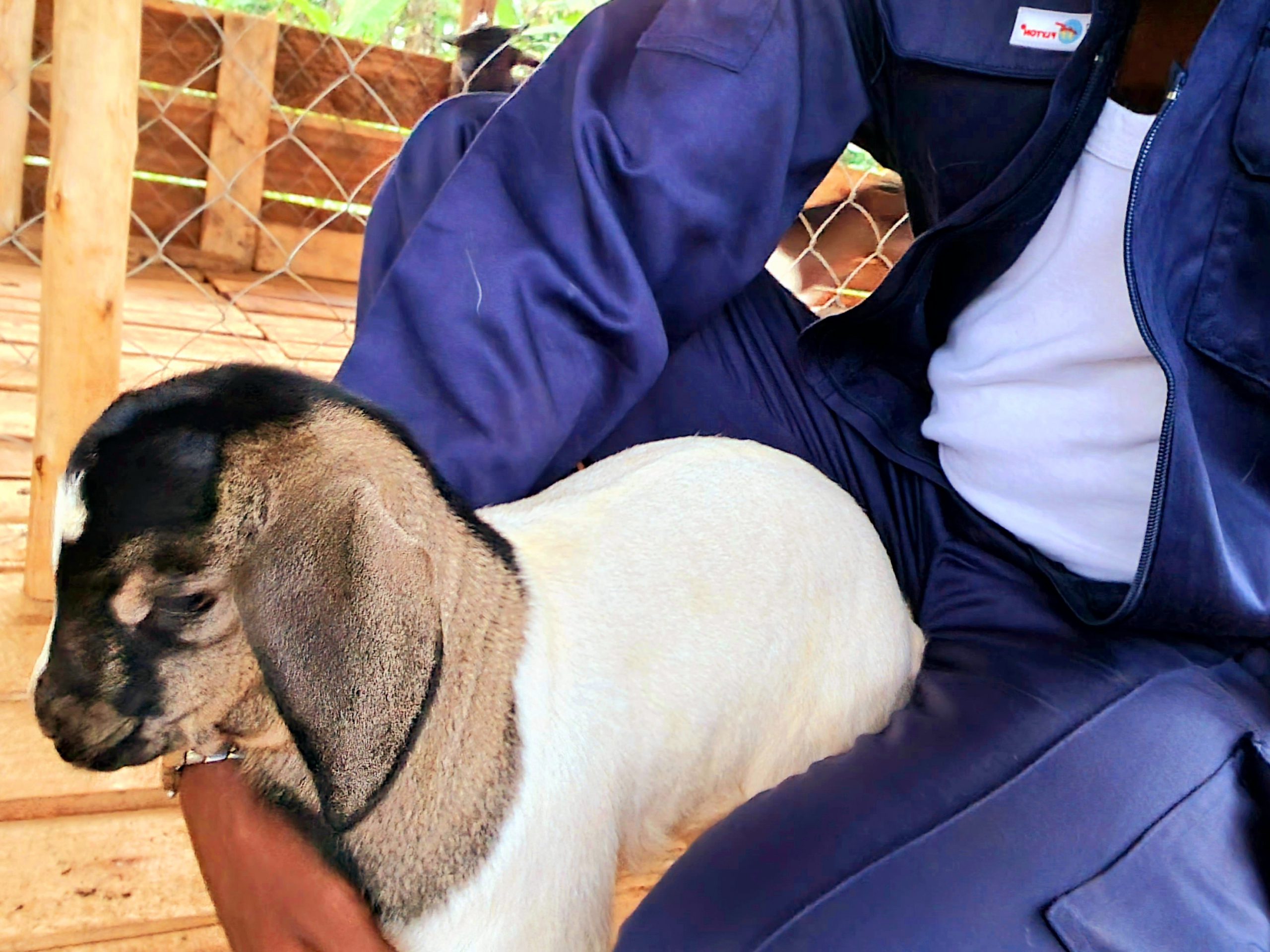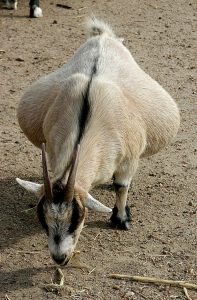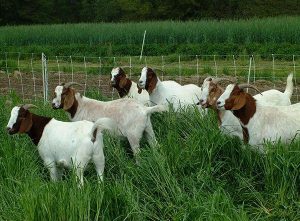Interventions to reduce kid mortalities
The following interventions are important for minimising the number of kids that die:
- Let the goats give birth in a quiet clean dry place without interference from other goats
- Provide a dry clean weather-proof shelter for newborn kids and their mothers
- Dip navels with iodine at birth to stop bacterial infections
- Give kids a drop of iodine on the tongue to prevent deficiencies
- Make sure that the kids are dry and bond with the mother and consume colostrum within an hour to six hours of being born
- Make sure the mother is healthy after giving birth and has enough good milk for her kid (no mastitis, retained placenta, etc.)
- Ensure that the doe have access to green fodder after giving birth to stimulate milk
- Cull does with poor mothering abilities or bad udders when they have weaned their kid.
- It is important to make sure that the lactating doe gets enough feed so that she produces sufficient milk to support the growth of the kid
- Give kids supplemental feed from a month old so that are able to cope with their mother’s poor milk production when feed is short
- Separate does and kids from the rest of the flock especially when in the kraal to avoid trampling, which may injure or kill kids
Castration
Castrate male kids at 3 months of age, using a Burdizzo.
NOTE: If you are using rubber rings to castrate, the kid must be less than 7 to 10 days of age. Using rubber rings on older goats can lead to death.
When using a Burdizzo, crush the cords from the two testicles separately and do them at slightly different distances from the body to ensure that there is continued blood flow to the testicles.
Do not crush the “false” teats when castrating the buckling.
Rearing orphans
It is important that newborn kids consume some colostrum. This first milk contains antibodies from the mother that are taken in by the kid and which protect it from disease. Kids should receive colostrum within the first hour after birth. You can give a kid colostrum from another doe if its own mother has died or has no milk.
A replacement for colostrum (the nutritional content)
Mix 500ml cow’s milk, 1 egg beaten in milk, 1 teaspoon cooking oil.
Give four small (150 to 200mls each) feeds/day for the first three days (heat to body temperature).
General milk replacer
- After the first three days feeding colostrum, feed normal cow’s milk three times a day from 400 ml up to 750 mm daily (i.e. 150 – 250 ml at each feed) for two weeks dropping to twice daily thereafter (i.e. 200 – 400 ml at each feed) for at least another 6 weeks.
- NOTE: YOU CAN USE UHT FULL CREAM COWS MILK AS A MILK REPLACER.
- If normal cow’s milk is not available it is possible to raise kids on a GOOD QUALITY milk replacer. Any milk replacer with a high fibre content on the label has vegetable products in it and is NOT good for kids.
- Incorrect mixing of milk replacers can quickly lead to a fatal bloat in the kid so it is best to try and get proper milk. If changing onto milk replacer from milk first mix the milk and milk replacer half/half for a number of days for the kid to get used to the new diet.
Note: Hygiene is very important when rearing orphans. Poor hygiene regarding can spread diseases between does (e.g. mastitis if you are putting orphan kids onto different does) and kids (e.g. orf can spread if the same bottle is used for more than one kid).
Creep feeding kids
It is essential that a kid is allowed to eat solid food or the rumen will not develop properly and it will lose condition or even die at weaning. Kids can be introduced to solid food at about 2 weeks old. The kids need to be supplemented until they join the flock. Kids should stay at home for 1-2 months and should be kept in a separate camp if possible to reduce their exposure to worms. Fresh clean water is very important as is a schedule for vaccinating and deworming the kid.
Different creep feeds
Build an area where the kid can “creep” away from its mother to eat and drink or give the kid feed and water when the mother goes out to graze. Creep feeding is a means of providing supplemental feed for kids that are still drinking from their mothers. It is most important at times when the does’ milk production is low (e.g. in wet season when feed is scarce) or when there are lots of twins and triplets.
There are different options for supplementing kids. The best feed would be one specially mixed and sold for growing lambs and kids called lamb creep feed. If this is not available they could be fed meat goat feed or even a Voermol Game block. If it is not possible to buy commercial feed, kids can eat the leaves of trees as well as long as the tannin content is not too high or the tree is poisonous. Fresh cut grass or hay for roughage is also a good idea, but avoid cutting grass from areas where the adult goats have been as they may have left worms behind.
If you are feeding dry feed to the kids, it must always be fresh and palatable to kid goats. When kids are young they prefer finely ground feed, but as they get older, coarser feeds are preferred, and whole grains are digested very efficiently. If you are buying commercial feed from a shop you should choose one that has crude protein (CP) content of approximately 18% and approximately 12 MJ energy (metabolizable)/kg DM. It also must not contain urea since young kids are very susceptible to urea toxicity. As the kids get older, you can use a feed that contains less protein. For example from weaning they can have a feed with 15-16% crude protein. Pelleted feeds are better because they make sure that the kids don’t select the “best” parts and leave the less desirable. When the creep feed is a concentrate, it is important to allow the kids access to good quality roughage. This will promote the development of proper rumen function.
Other factors to consider include:
- Kids begin to nibble at feed and hay at a very early age. Some kids may have a functional rumen and be chewing their cud by two weeks of age. Therefore, creep should be available by the time kids are 2-3 weeks old. They do not, however, begin to consume significant quantities until they are about 4 weeks old.
- Young kids will not consume stale or contaminated feed. Clean out old feed that accumulates in the troughs at least once per week. It can be fed to older animals, thus avoiding wastage.
- Kids must have access to clean water in, or close to, the creep feeder.
Feeder design
The idea is to allow kids access to feed while precluding access to does and older animals. Most creep feeders are constructed by placing troughs in a pen or by building a pen around a feeder in the pasture. Either way, the challenge is to design a gate or entrance through which only the kids can pass. Spacing between the vertical bars of the gate needs to be 12-15 cm.
Allow 20 cm of feeder space per kid. The feeding trough should be constructed with barriers on top so that contamination from kids standing or playing in the feeder is minimized.
The fence or pen in which the creep feeder is located must be more durable than a typical pasture or field fence because older goats will try hard to gain access to the creep feed.
Creep feeders should be located near water, shade or other places where goats relax during the day. Kid goats enjoy climbing. Placing stumps, cable spools or large rocks in larger creep pens or near the creep feeder may provide an additional attraction.
Management
The continuous presence of dry, fresh feed is important. Never let a creep feeder get completely empty.
Feeders should be protected from rain. Wet feed will likely mould and should therefore be removed from a creep feeder immediately.
Open troughs such as pieces of gutter or lengths of PVC pipe cut in half with ends blocked will work, but must be cleaned and filled frequently (at least once a day). Also, kids will get in the troughs, and urinate and defecate on the feed, which will lead to wastage. Deep troughs or those with sloping bottoms can trap kids and result in suffocation. These “feed troughs” can be attached onto the side of the creep pen and raised off the ground. You can put a board underneath the trough to keep their feet out of the troughs. This forces the kids to stand on their hind legs to eat and keeps the feed clean.
Grazing
Creep feed does not necessarily have to be offered in a feeder or poured out of a sack. Creep grazing is a viable option for boosting weight gain by nursing kids, using a high quality forage such as lucerne, soybeans, cowpeas, groundnuts or clovers.
Precautions
Prevent disease outbreaks amongst your kids. Outbreaks of orf may occur because they are sharing the same feed and water. It may be worth vaccinating against orf with a vaccine . Hygiene is important and the pens should be disinfected regularly to control germs, especially to prevent outbreaks of coccidiosis. Another option is to use a commercial feed that contains medicines called coccidiostats.
Weaning
Weaning is when the kid stops drinking from its mother – it normally happens automatically at about 3 months of age (weighing approximately 20kg). Separating kids (forcing them to wean) is a very stressful time for kids, so keep feeding them supplementary feed while they get used to not drinking milk.
sharing is caring!




